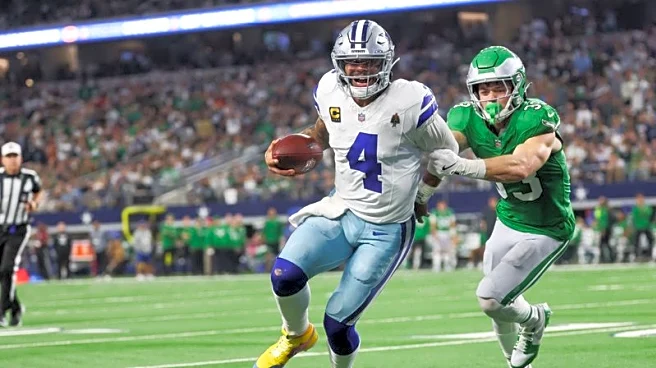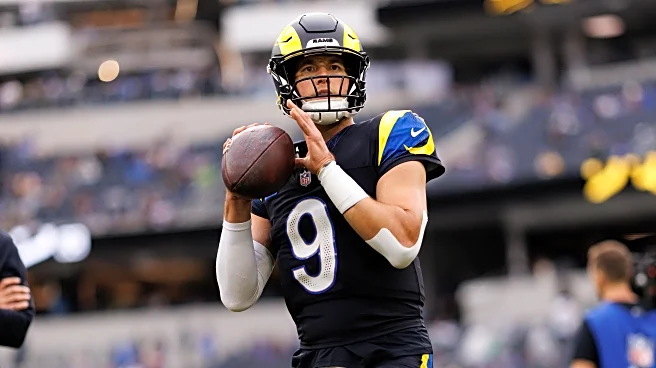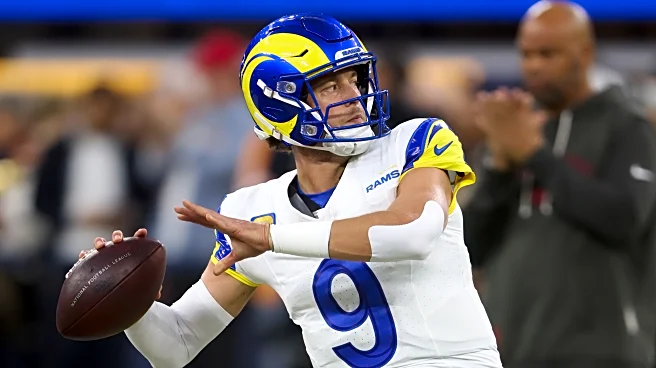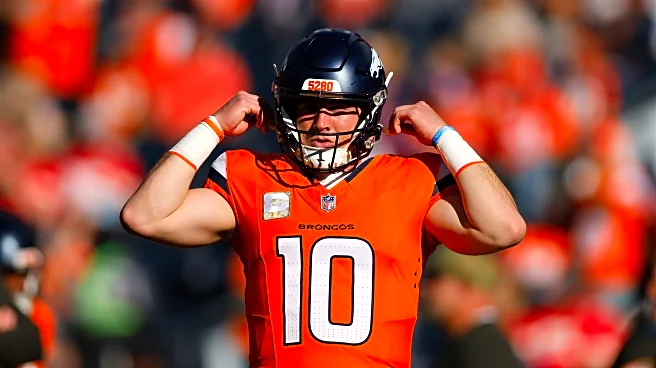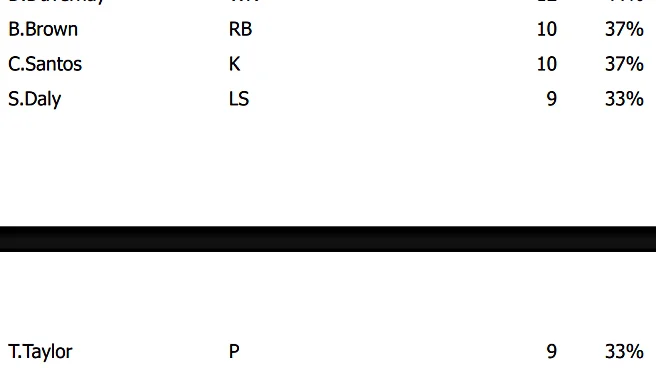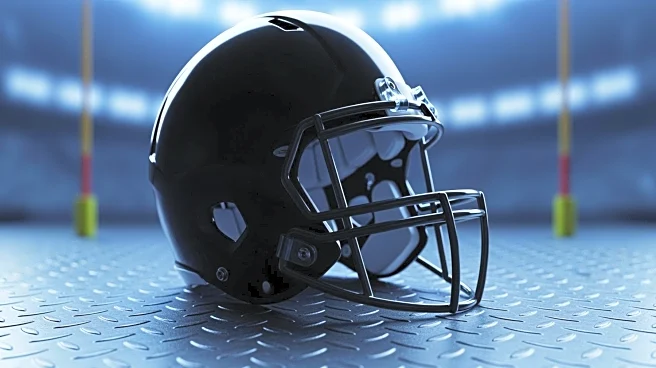As of this writing, Caleb Williams has a completion percentage of only 59.2% in 2025.
Among the 34 qualified quarterbacks by Pro Football Reference, it’s the second-lowest completion rate in the NFL. Only
J.J. McCarthy has a lower completion percentage than Williams coming out of Week 12, and it’s a far cry from the 70% completion percentage goal that Bears head coach Ben Johnson gave the second-year QB going into the season.
Let’s dig a little bit deeper into that. To the naked eye, that completion percentage isn’t very good at all. Certainly, there are some times on tape where Williams can airmail his passes. I’d argue there are a handful of throws a game where he just outright misses open targets with inaccurate throws.
But is Caleb’s inaccuracy as big of an issue as his completion percentage might indicate?
Among the top 32 quarterbacks in the NFL in drop backs — taking the player on each team with the most passing attempts this season — Williams has the sixth-highest depth of target average at 9.2 yards, per PFF. Coincidentally, in first place in that average is J.J. McCarthy, who has a brutal 54.1% completion percentage but has the most difficult task per average throw with a 10.1 yards depth average.
That’s not to entirely excuse Williams’ completion percentage. Ahead of him in the ADOT average rankings are the likes of Sam Darnold and Drake Maye, both of whom rank in the top four in the NFL in completion percentage. But it does provide some insight into why his completion percentage is low: he’s being asked to execute more difficult tasks than the average NFL quarterback.
In particular, the Bears are asking a lot from him to move the ball down the field. Going into Week 13, he has thrown 51 passes that have traveled beyond 20 air yards past the line of scrimmage. Only Bo Nix and Patrick Mahomes have thrown more deep balls this season. Of the 18 starting quarterbacks who have started in every game their respective team has played, Williams has the second-highest percentage of deep ball usage behind only Jalen Hurts.
When he’s being tasked with executing down the field, the Bears have seen tremendous efficiency on the deep ball. Here’s where Williams ranks in the NFL among quarterbacks on deep throws:
- 101.7 passer rating (9th)
- 5 touchdowns (T-8th)
- 90.4 PFF grade (13th)
- 45.5% adjusted completion percentage (11th)
Williams also has a 4.2% “big time throw” percentage, which ranks 15th in the league. That’s not incredible, but it certainly isn’t bad, either.
The adjusted completion percentage is arguably more telling than his actual completion percentage on the deep ball, which ranks just 24th at 35.3%. Reason being: the adjusted completion percentage accounts for dropped passes and throwaways. Caleb has had 21.7% of his deep passes on target yet outright dropped by his receivers, which is the fourth-highest rate in the NFL. When you’re throwing the deep ball as often as he is, that’s a lot of yards being left on the table.
This doesn’t answer every single question about Williams’ completion percentage, but it shows one thing: he’s throwing the ball down the field more than most quarterbacks — which naturally leads to a lower percentage of conversion than short dump-off passes — and he’s doing better on the deep ball than most other quarterbacks around the league.
There are valid criticisms of Williams’ game from a numbers perspective, too. His adjusted completion percentage on passes behind the line of scrimmage is 88.5%. That sounds great on paper, but it actually only ranks 31st among the 33 quarterbacks qualified for that statistic. For reference, Sam Darnold hasn’t thrown a single incompletion on his 25 passes behind the line of scrimmage, and Jalen Hurts’ only two incompletions of his 37 attempts were both dropped.
That checks out with what I’ve seen on film. Over the course of my weekly film breakdowns of Caleb on my Patreon, I’ve noted that his accuracy on short dump-off passes is more erratic than the average NFL quarterback. I believe this comes down to a lack of comfort in terms of his footwork, as he seems a little jittery at times when asked to execute a quick dropback to get the ball out quickly. It can lead to routine passes getting airmailed too often.
That jittery footwork isn’t as prevalent on throws further down the field, though. He looks comfortable going through five-step drops and even seven-step drops, and his cadence at the top of his dropback is poised and collected. That plays a big role in his success moving down the field.
This chart from PFF shows where Williams has been most efficient this season. He’s been unbelievable on deep throws across the middle of the field, and he’s generally been doing a fantastic job of hitting targets up the middle. The intermediate throws to the outside show that route concepts like deep outs and corners have been an issue for him this season.

However, you can see that Ben Johnson has adjusted his gameplay accordingly to play to Williams’ strengths. There’s been an increase in deep passes over the course of the season, and in recent weeks, we’re seeing the Bears target the middle of the field on a higher percentage of those throws than they did earlier in the year.
The chart above shows that most of Williams’ deep/intermediate throws have happened across the middle, but that wasn’t always the case. In Week 1 against the Vikings, here was his directional stat line from 10+ yards out:
- Outside left: 1-for-2, 22 yards
- Between numbers: 3-for-5, 44 yards, 1 TD
- Outside right: 2-for-4, 47 yards
Here are the same statistics from Week 2 against the Lions:
- Outside left: 1-for-1, 11 yards
- Between numbers: 2-for-4, 39 yards
- Outside right: 3-for-5, 67 yards
For comparison, here’s the stat line from his Week 11 matchup against the Vikings:
- Outside left: 0-for-4, 0 yards
- Between numbers: 4-for-6, 70 yards
- Outside right: 0-for-3, 0 yards
And his most recent game on Sunday against the Steelers:
- Outside left: 0-for-0, 0 yards
- Between numbers: 5-for-9, 98 yards, 1 TD
- Outside right: 0-for-3, 0 yards
On those passes in between the numbers from 10+ air yards out, that’s an elite passer rating of 130.79, for those keeping track at home.
So when evaluating Caleb Williams’ low completion percentage, there are both valid criticisms and reasonable explanations as to why his numbers appear subpar. In all, though, I’d argue a lot of the reasoning makes sense. To summarize:
- Williams is throwing the ball deeper than most quarterbacks
- He’s actually been better on the deep ball than most quarterbacks
- Ben Johnson went through a feeling out period to get a sense of what Williams was most comfortable with, and he’s been more effective as the Bears play to his strengths more
- Caleb has been extremely efficient throwing across the middle of the field
- The accuracy outside the numbers needs to get better
- He has shown below-average accuracy on screens and flat routes
I hope this provides some context to Caleb Williams’ accuracy so far this season. At the very least, it provides more than a First Round Mock tweet.


